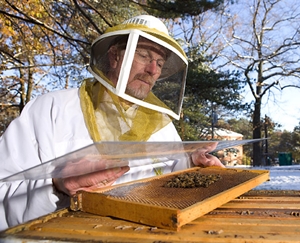
Jeffrey Pettis, of USDA’s Bee Research Laboratory in Beltsville, Maryland, is a co-author of the study. (Agricultural Research Service, USDA)
Researchers at North Carolina State University, University of Maryland, Pennsylvania State University, and U.S. Department of Agriculture found a mysterious disease and aberrant queen behavior highly associated with the recent widespread death of bee colonies. The authors published their findings in a recent issue of the journal Preventive Veterinary Medicine.
The team led by University of Maryland entomologist Dennis vanEnglesdorp tracked 80 commercial honey bee colonies over 10 months in 2007 and 2008 for changes in the colonies that affect the health and survival of the colonies. That period of time coincided with the working season of the bee colonies, which traveled up and down the east coast of the U.S. for crop pollination and honey production.
The researchers used uniform measures of colony health, including symptoms of disease, condition of the queen, and colony death defined as the absence of adult bees. The authors report that during the study, 56 percent of the colonies died.
The team found the factor associated most highly with bee colony death is a little known disease called idiopathic brood disease syndrome or IBDS. The presence of IBDS this time, however, did not follow the disease’s usual pattern. “Historically, we’ve seen symptoms similar to IBDS associated with viruses spread by large-scale infestations of parasitic mites,” says co-author David Tarpy, an entomology professor at NC State. “But now we’re seeing these symptoms, a high percentage of larvae deaths, in colonies that have relatively few of these mites.”
Colonies affected by IBDS were 3.2 times more likely to die than other colonies over the course of the study. A close second to IBDS was what the researchers call a “queen event;” colonies where the queen malfunctioned were 3.1 times more likely to die than the others studied. The authors report honey bee colonies share a single queen, and if the worker bees sense something wrong with the queen, they try to replace her, with worker-bee actions sometimes damaging to the colony.
The findings indicate to Tarpy how much they still don’t know about the problem. The study “shows that IBDS is a significant problem that we don’t understand very well,” says Tarpy. “It also highlights that we need to learn more about what causes colonies to reject their queens.”
The study was funded by USDA and the National Honey Board.
Read more:
- Research on Insects Leads to Forestry Biochemical Start-Up
- Economic Growth Affected by Parasitic, Insect-Spread Disease
- Pfizer Develops Equine Vaccine from University Research
- Biopharm, Monsanto to Partner on Agricultural Biotechnology
- Agriculture Research Companies to Partner on Insect Control
* * *

 RSS - Posts
RSS - Posts
I never imagined I would need to understand this thank goodness for the internet